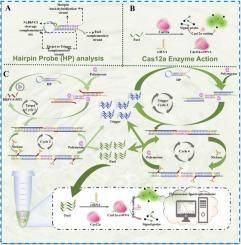结合CRISPR/Cas12a的多功能单发夹介导酶级联四联富集系统用于超灵敏汉坦病毒检测
IF 3.7
1区 化学
Q1 CHEMISTRY, ANALYTICAL
引用次数: 0
摘要
汉坦病毒(HV)在世界范围内广泛分布。它会引起肾综合征出血热(HFRS)和汉坦病毒心肺综合征(HCPS),死亡率分别高达15%和40%。在这项工作中,设计了一种基于发夹的酶级联四重富集(SH-ECE)系统,偶联CRISPR/ cas12a作为检测大别山正hantavirus (DBSV)的传感平台。在两种酶的辅助下,仅用一个发夹探针(HP)就可以构建SH-ECE体系。当目标基因存在时,SH-ECE系统将被激活,四个不同的循环反应将依次发生。这些反应不断进行,实现四倍扩增,输出大量模拟靶DNA和功能链,参与后续反应。令人印象深刻的是,CRISPR/ cas12a技术的引入进一步放大了信号,同时增强了传感平台的特异性和灵敏度,甚至可以区分单碱基、双碱基和三碱基突变的RNA。该传感平台可以在50 fM到50 nM的线性范围内检测到LOD为16.7 fM (S/N= 3)的DBSV。用人血清标本和啮齿动物血清标本验证了该方法的适用性。基于此,该传感方法的研究可以广泛应用于指导和促进基于CRISPR/Cas和SH-ECE系统的检测的进一步发展。本文章由计算机程序翻译,如有差异,请以英文原文为准。

Multifunctional single-hairpin mediated enzyme-cascade quadruple enrichment system coupled with CRISPR/Cas12a for ultrasensitive hantavirus detection
Hantavirus (HV) is widely distributed worldwide. It causes hemorrhagic fever with renal syndrome (HFRS) and hantavirus cardiopulmonary syndrome (HCPS), which has a mortality rate of up to 15 % and 40 %. In this work, a single hairpin-based enzyme-cascade quadruple enrichment (SH-ECE) system coupled with CRISPR/ cas12a was designed as a sensing platform for the detection of a Orthohantavirus dabieshanense (DBSV). With the assistance of two enzymes, the SH-ECE system can be constructed by using only one hairpin probe (HP). When the target gene is present, the SH-ECE system will be activated, and four different cyclic reactions will occur sequentially. These reactions proceed continuously, realizing quadruple amplification and outputting a large number of mimic target DNA and functional strands, which will participate in the subsequent reactions. Impressively, the introduction of CRISPR/ cas12a technology further amplifies the signal while enhancing the specificity and sensitivity of the sensing platform, even enabling the discrimination of RNA with single-, double-, and triple-base mutations. The sensing platform can detect DBSV with a LOD of 16.7 fM (S/N = 3) for linearity spanning from 50 fM to 50 nM. The applicability of this method was validated using both human serum specimens and rodent serum samples. Based on this, the research on this sensing method can be widely applied to guide and facilitate the further development of CRISPR/Cas and SH-ECE system-based assays.
求助全文
通过发布文献求助,成功后即可免费获取论文全文。
去求助
来源期刊

Sensors and Actuators B: Chemical
工程技术-电化学
CiteScore
14.60
自引率
11.90%
发文量
1776
审稿时长
3.2 months
期刊介绍:
Sensors & Actuators, B: Chemical is an international journal focused on the research and development of chemical transducers. It covers chemical sensors and biosensors, chemical actuators, and analytical microsystems. The journal is interdisciplinary, aiming to publish original works showcasing substantial advancements beyond the current state of the art in these fields, with practical applicability to solving meaningful analytical problems. Review articles are accepted by invitation from an Editor of the journal.
 求助内容:
求助内容: 应助结果提醒方式:
应助结果提醒方式:


